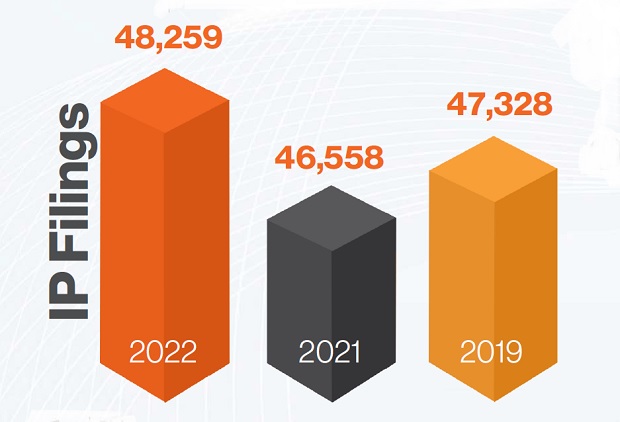The volume of intellectual property (IP) applications at the IP Office of the Philippines (IPOPHL) in 2022 registered a new record-high as the Philippine economy showed a strong growth momentum where IP is leveraged as a capital for resilient growth.
Overall, last year’s applications totaled 48,259, 3.7% higher than the 46,558 in 2021 and 2% up from the previous record-high of 47,328 in 2019.
Individually, trademark and patent filings, as well as copyright registrations, achieved all time-highs.
“The strong uptake in 2022 IP filings shows how aggressive businesses are in seizing opportunities in the more upbeat economy and the digitalization of business interactions as intensified by the pandemic,” IPOPHL director general Rowel S. Barba said, citing the country’s 7.6% gross domestic product growth which was faster than the 5.7% in 2021 and the fastest since 1976 as strong household consumption and gross capital formation fueled the growth.
“More Filipinos are beginning to see the competitive value of having a degree of control over their most prized assets: the products of their minds, their IPs. More businesses and entrepreneurs are integrating IP into their strategies for success not despite the pandemic and other economic and environmental challenges in our midst but because of them,” Barba added.
Trademark
The lion’s share of 2022 filings were trademark applications — an indicator for business starts with the introduction of new brands — totaled 41,235 and grew by 4% year-on-year. Of this, 25,253 or 61% were by residents and 39% or 15,982 by non-residents.
Bulk of trademark filings were in pharmaceutical, health and cosmetic products (with an 18.4% share), followed by agricultural products and services (16.6%) and scientific research, information and communication technology (14.9%).
Patents
Meanwhile, applications for patents — which indicates the appetite to bring possibly commercially viable inventions to market — booked the fastest growth as volumes expanded 9.3% to 4,403. Non-residents accounted for 89% or 3,918 while 11% or 485 were by residents.
Top patent applications were in pharmaceuticals (28.9%); organic fine chemistry (12.1%); and digital communications (8.3%).
UM and ID
Filings for utility models (UMs) — a patent-like IP right to protect innovations – declined to 1,386 from 1,615. Residents accounted for 95% with 1,315 counts.
Most UMs filed were in fields of food chemistry (44.6%); other special machines (8.8%); and basic materials chemistry (4.9%).
Industrial designs (ID) — an IP for protecting the three-dimensional look of a product – edged down to 1,235 from 1,265 with non-residents at about 55% or 678 of filers.
Top industries for ID applications were in means of transport or hoisting (19.7%); packages and containers for the transport or handling of goods (8.7%); and furnishing (8.3%).
Copyright
Meanwhile, registrations for copyright grew by 3,706, a 73% jump from 2,141 in 2021 as creators scramble to find better ways to protect their copyright in online and physical markets.
Copyright registrations for the period were mainly driven by books, pamphlets, articles, e-books, audio books, comics, novels and other writings (36%); followed by literary, scholarly, scientific and artistic works (19.7%); and drawings, paintings, architectural works, sculpture, engraving, prints, lithography or other works of art, models or designs for works of art (8.6%).
Outlook and strategies
To maintain the momentum in IP creation, the IPOPHL said it will focus on three key strategies:
- Improve its IT infrastructure to ensure the consistent availability of online services and smooth transactions;
- Bring IP to more areas to ensure regional inclusive growth; and
- Engage in the global IP community to gain new practices that would help IPOPHL and IP rights holders and users best respond to the digitalization of businesses.
Barba recognized the headwinds businesses may face amid inflation pressures and uncertainties brought by the global slowdown and geopolitical tensions but reminded of the long-term benefits of IP.
“Amid a cautiously optimistic outlook for this year, some businesses may tighten the belt on spending but hopefully it does not come at the cost of failing to sufficiently protect their high-value IP assets,” Barba said
“Those who bring IP to the center of their strategies could have greater chances of survival as valuable IP assets can elevate companies to greater heights of innovation, creativity and brand identity – all critical determining factors in a company’s long-term growth and competitiveness,” he added.
The IPOPHL chief also reminded of the social welfare opportunities from strengthening IP protection.
“With the incentive of the IP system, we may even benefit as the returns they generate from their IP assets may not only help them weather the looming economic downturn but also create lasting effects that change society for the better,” Barba added.




